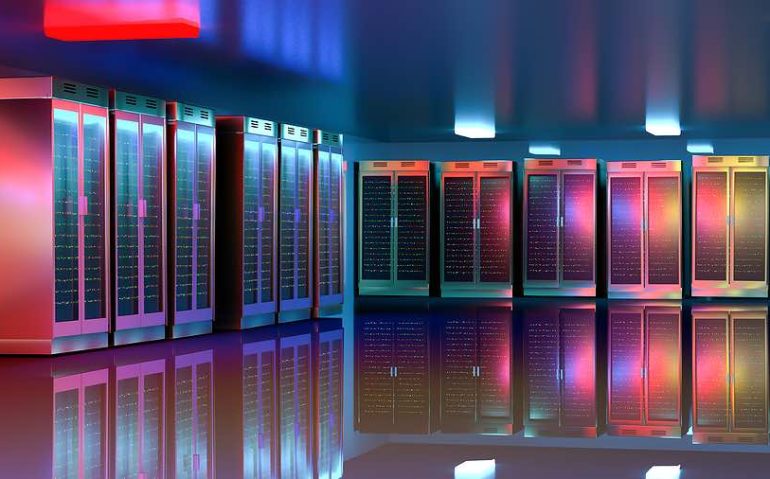In the era of artificial intelligence (AI) and massive data processing, the world has witnessed a tremendous increase in the demand for data centers, also known as server farms. These data centers are the backbone of countless online services, handling vast amounts of information and powering AI algorithms that have become an integral part of our lives. However, behind the convenience and efficiency lies a concerning truth – the tremendous environmental toll caused by the insatiable energy appetite of these server farms.
A data center’s voracious energy consumption can be mind-boggling. Data centers consume about 1,000 kWh per square meter, approximately ten times the power a typical American home uses. The server racks and cooling systems are the primary culprits behind this high energy consumption. Server racks, the backbone of data centers, require constant maintenance and cooling to ensure smooth and efficient operation. However, these cooling systems are often inefficient, gobbling up around 70% of the total energy used in a data center.
One of the biggest challenges with data centers is the heat generated by their enormous computing power. The internal temperature of hot aisles in data centers can range from 85 to 115 degrees Fahrenheit. To maintain optimal working conditions, cooling systems must be in place. The heat generated is immense, and the cooling systems, also running on electricity, consume even more energy to cool down the space.
The energy consumption of servers in data centers can vary depending on their workload and demand, with the average annual power ranging from 1,800 to 1,900 kWh per year per server. When considering the scale at which data centers operate, these seemingly small numbers add to massive energy consumption.
Why do data centers consume so much energy? The answer lies in their multifaceted role, providing many services and support simultaneously. Furthermore, many data centers are located in hot and humid regions with poor air quality, exposing them to additional risks of equipment degradation, HVAC failure, and power outages. This necessitates a high level of energy usage for data storage.
On a global scale, data centers are responsible for consuming anywhere from 260 to 340 TWh of electricity annually, accounting for around 1 to 1.4% of the world’s total electricity usage. With the world’s data transfer projected to grow exponentially in the coming years, this energy consumption is only expected to rise further.
Data centers’ power density is another concerning aspect, with the typical power density reaching around 150 watts per square foot and sometimes even as high as 300 watts. This high density, coupled with the soaring energy demands, raises alarms about their environmental impact.
While the world depends on data centers for seamless connectivity and instant access to information, the colossal energy consumption raises serious environmental concerns. The implications of this energy-intensive infrastructure include increased greenhouse gas emissions and a substantial carbon footprint, further contributing to the global climate crisis.
Addressing this issue requires innovative and sustainable solutions. Some data centers are exploring immersion cooling, a technique that utilizes non-conductive fluids to dissipate heat more efficiently, reducing the need for traditional cooling systems. Additionally, renewable energy sources such as solar, wind, and hydroelectric power can help reduce the environmental impact of data centers by providing cleaner electricity.
The insatiable energy demands of server farms and data centers are significantly damaging the environment. The colossal energy consumption required to maintain and cool data center equipment is causing substantial carbon emissions and contributing to the climate crisis. To mitigate these environmental impacts, a collective effort is needed to develop and adopt sustainable practices and alternative energy sources in the data center industry. Only then can we strike a balance between technological advancement and environmental responsibility in the age of AI?
The Surprising Environmental Cost of ChatGPT: A Breakdown of Server Expenses
Artificial intelligence (AI) technology has rapidly evolved in recent years, offering a wealth of utilities ranging from natural language processing to autonomous vehicles. While many of these advances have proven invaluable tools for businesses and consumers alike, it’s important to consider the potential impacts on our environment. A recent report unveils some alarming figures about one of the most popular AI models: ChatGPT.
According to a new analysis by Dylan Patel, Chief Analyst at SemiAnalysis, it costs around $700,000 daily to run ChatGPT, the innovative generative AI chatbot developed by OpenAI. This astounding figure equates to an average cost of 36 cents per question.
While this massive expenditure is eye-opening from a financial perspective, it also has significant environmental implications. This computational power comes at a high price, not only monetarily but also in terms of energy usage and carbon emissions.
ChatGPT currently relies on high-performance Nvidia GPUs to perform its impressive feats of natural language generation. With OpenAI’s expansion and increasing demand for the chatbot, the report estimates that an additional 30,000 GPUs will be required to keep up with its commercial growth trajectory in 2023.
The crux of the issue is that these high-powered GPUs consume a substantial amount of electricity. This energy consumption translates directly into increased carbon emissions, particularly in regions where the power grid relies heavily on fossil fuels.
These figures suggest an urgent need for more efficient and sustainable solutions. Microsoft, one of OpenAI’s principal investors and collaborators, may have an answer. Reports indicate that Microsoft is currently developing proprietary AI chips. This development could potentially lead to a significant reduction in energy consumption and, in turn, the environmental impact.
However, it’s also essential to consider the lifecycle impact of these new chips. This includes the energy and materials needed for their manufacture and the waste generated when they are no longer usable.
While AI technologies like ChatGPT provide many exciting possibilities for business, entertainment, and even education, the scale of their energy usage can no longer be ignored. As we move further into an era of digital technology, finding sustainable, environmentally friendly solutions for powering these technologies is paramount.
The server cost for ChatGPT and many other AI applications has raised a critical question: How can we reconcile our technological aspirations with our environmental responsibilities? As AI technologies continue to grow and evolve, the answer to this question will shape the future of the industry and our planet.
Ultimately, we must strive for a balance between innovation and sustainability. For companies like OpenAI and Microsoft, the challenge is to continue driving the extraordinary potential of AI forward while making conscious efforts to mitigate its environmental impact. The long-term success of these technologies—and the health of our planet—depends on it.






